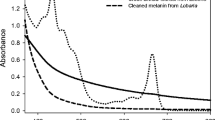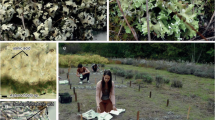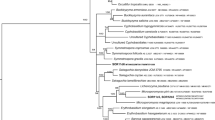Abstract
Synthesis of the cortical dibenzofuran derivative usnic acid and the medullary depsidone salazinic acid was studied in Xanthoparmelia stenophylla thalli from which the compounds had been removed by acetone rinsing prior to a 21-day field experiment with UV absorbing and transmitting screens. Natural levels of ultraviolet radiation clearly induced the re-synthesis of usnic acid. The re-synthesis was boosted by the addition of ribitol, the carbohydrate delivered from the Trebouxia photobiont to the mycobiont. Salazinic acid was also weakly induced by UV. Re-synthesis was relatively low, up to 2.5 and 3.1% of start values for usnic and salazinic acid, respectively. However, given that the natural content of both compounds was high, constituting 12% of thallus dry weight, the absolute amounts of lichen compounds re-synthesised were not so small. We also studied the extractability of nine extracellular lichen compounds in three species X. stenophylla, Hypogymnia tubulosa, and Vulpicida pinastri, and found two distinct fractions of cortical compounds, one major that was completely extractable from living lichens and one minor that was only extractable with grinding. Medullary compounds were completely extracted without grinding. These findings did not influence the relative differences between treatments in our experiment, but may be of importance for future assessments of, e.g., quantitative studies of extracellular lichen compounds.



Similar content being viewed by others
References
Ahmadjian V (1993) The lichen symbiosis. Wiley, New York
Ahti T, Hawksworth DL (2005) Xanthoparmelia stenophylla, the correct name for X. somloensis, one of the most widespread usnic acid containing species of the genus. Lichenologist 37:363–366
BeGora MD, Fahselt D (2001a) Photolability of secondary compounds in some lichen species. Symbiosis 31:3–22
BeGora MD, Fahselt D (2001b) Usnic acid and atranorin concentrations in lichens in relation to bands of UV irradiance. Bryologist 104:134–140
Bjerke JW, Lerfall K, Elvebakk A (2002) Effects of ultraviolet radiation and PAR on the content of usnic and divaricatic acids in two arctic-alpine lichens. Photochem Photobiol Sci 1:678–685
Bjerke JW, Elvebakk A, Dominguez B, Dahlback A (2005a) Seasonal trends in usnic acid concentrations of Arctic, alpine and Patagonian populations of the lichen Flavocetraria nivalis. Phytochemistry 66:337–344
Bjerke JW, Gwynn-Jones D, Callaghan T (2005b) Effects of enhanced UV-B radiation in the field on the concentration of phenolics and chlorophyll fluorescence in two boreal and arctic-alpine lichens. Environ Exp Bot 53:139–149
Caldwell MM, Robberecht R, Flint SD (1983) Internal filters: prospects for UV-acclimation in higher plants. Physiol Plant 58:445–450
Cockell CS, Knowland J (1999) Ultraviolet radiation screening compounds. Biol Rev 74:311–345
Dahlman L, Palmqvist K (2003) Growth in two foliose tripartite lichens, Nephroma arcticum and Peltigera aphthosa: empirical modelling of external vs internal factors. Funct Ecol 17:821–831
Elix JA (1996) Biochemistry and secondary metabolites. In: Nash III TH (ed) Lichen biology. Cambridge University Press, Cambridge, pp 154–180
Fahselt D, Alstrup V (1997) Visualization of extracellular deposits in recent and subfossil Umbilicaria hyperborea. Lichenologist 29:547–557
Feige GB, Lumbsch HT, Huneck S, Elix JA (1993) Identification of lichen substances by a standardized high-performance liquid-chromatographic method. J Chromatogr 646:417–427
Gauslaa Y (2005) Lichen palatability depends on investments in herbivore defence. Oecologia 143:94–105
Gauslaa Y, McEvoy M (2005) Seasonal changes in solar radiation drive acclimation of the sun-screening compound parietin in the lichen Xanthoria parietina. Basic Appl Ecol 6:75–82
Gauslaa Y, Solhaug KA (2001) Fungal melanins as a sun screen for symbiotic green algae in the lichen Lobaria pulmonaria. Oecologia 126:462–471
Gauslaa Y, Solhaug KA (2004) Photoinhibition in lichens depends on cortical characteristics and hydration. Lichenologist 36:133–143
Gauslaa Y, Ustvedt EM (2003) Is parietin a UV-B or a blue-light screening pigment in the lichen Xanthoria parietina? Photochem Photobiol Sci 2:424–432
Honegger R (2003) The impact of different long-term storage conditions on the viability of lichen-forming ascomycetes and their green algal photobiont, Trebouxia spp. Plant Biol 5:324–330
Huneck S, Yoshimura I (1996) Identification of lichen substances. Springer, Berlin Heidelberg New York
Hutzler P, Fischbach R, Heller W, Jungblut TP, Reuber S, Scmitz R, Veit M, Weissenböck G, Schitzler JP (1998) Tissue localization of phenolic compounds in plants by confocal laser scanning microscopy. J Exp Bot 49:953–965
Ingolfsdottir K (2002) Usnic acid. Phytochemistry 61:729–736
Jordan BR (1996) The effects of ultraviolet-B radiation on plants: a molecular perspective. Adv Bot Res 22:97–162
Lange OL, Green TGA, Reichenberger H, Hesbacher S, Proksch P (1997) Do secondary substances in the thallus of a lichen promote CO2 diffusion and prevent depression of net photosynthesis at high water content? Oecologia 112:1–3
McEvoy M, Solhaug KA, Gauslaa Y (2006) Ambient UV irradiation induces a blue pigment in Xanthoparmelia stenophylla. Lichenologist 38:285–289
Nybakken L, Solhaug KA, Bilger W, Gauslaa Y (2004) The lichens Xanthoria elegans and Cetraria islandica maintain a high protection against UV-B radiation in Arctic habitats. Oecologia 140:211–216
Öquist G, Huner NPA (2003) Photosynthesis of overwintering evergreen plants. Annu Rev Plant Biol 54:329–355
Palmqvist K (2000) Carbon economy in lichens. New Phytol 148:11–36
Pöykkö H, Hyvärinen M, Backor M (2005) Removal of lichen secondary metabolites affects food choice and survival of lichenivorous moth larvae. Ecology 86:2623–2632
Richardson DHS, Smith DC (1968a) Lichen physiology X. The isolated algal and fungal symbionts of Xanthoria aureola. New Phytol 67:69–77
Richardson DHS, Smith DC (1968b) Lichen physiology IX. Carbohydrate movement from the Trebouxia symbiont of Xanthoria aureola to the fungus. New Phytol 67:61–68
Solhaug KA, Gauslaa Y (1996) Parietin, a photoprotective secondary product of the lichen Xanthoria parietina. Oecologia 108:412–418
Solhaug KA, Gauslaa Y (2001) Acetone rinsing—a method for testing ecological and physiological roles of secondary compounds in living lichens. Symbiosis 30:301–315
Solhaug KA, Gauslaa Y (2004) Photosynthates stimulate the UV-B induced fungal anthraquinone synthesis in the foliose lichen Xanthoria parietina. Plant Cell Environ 27:167–176
Solhaug KA, Gauslaa Y, Nybakken L, Bilger W (2003) UV-induction of sun-screening pigments in lichens. New Phytol 158:91–100
Veit M, Bilger W, Mühlbauer T, Brummet W, Winter K (1996) Diurnal changes in flavonoids. J Plant Physiol 148:478–482
Acknowledgements
We are grateful to Dr. H. J. Sipman (Botanischer Garten und Botanisches Museum Berlin-Dahlem, Berlin, Germany) for providing samples of lichen compounds and to Prof. J. A. Elix (The Australian National University, Canberra, Australia) for advice regarding the identity of some of the compounds.
Author information
Authors and Affiliations
Corresponding author
Rights and permissions
About this article
Cite this article
McEvoy, M., Nybakken, L., Solhaug, K. et al. UV triggers the synthesis of the widely distributed secondary lichen compound usnic acid. Mycol Progress 5, 221–229 (2006). https://doi.org/10.1007/s11557-006-0514-9
Received:
Revised:
Accepted:
Published:
Issue Date:
DOI: https://doi.org/10.1007/s11557-006-0514-9




